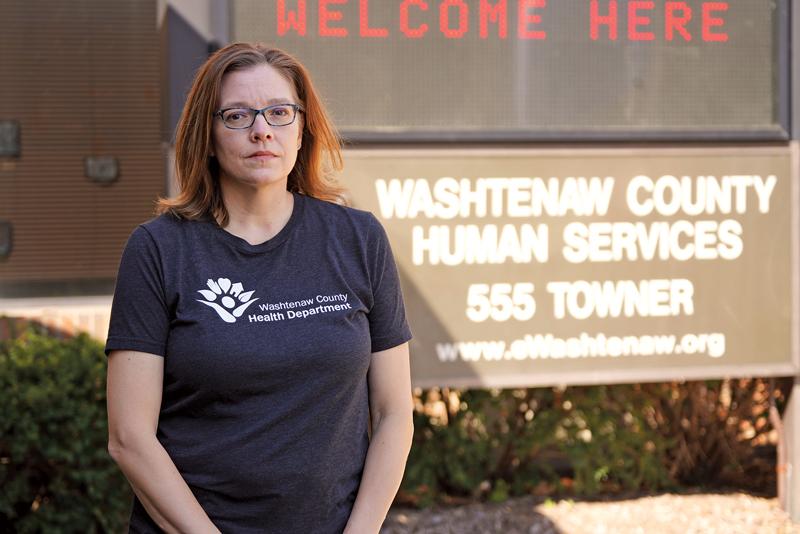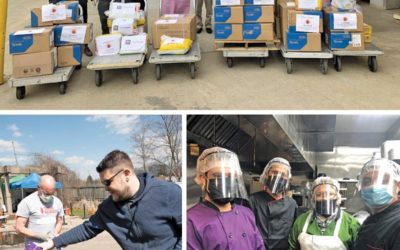Susan Ringler-Cerniglia is the storm tracker for the Covid-19 pandemic in Washtenaw County. As head of communications for the county health department, she warned in late January that health officials were “actively monitoring the Novel Coronavirus 2019 outbreak originating in Wuhan, China.”
On March 11, she reported the first infections in Michigan, then on March 13 the first in the county. The first local death came on March 22. By mid-April, fifteen county residents had died.
Ringler-Cerniglia, forty-eight, arrives at the county’s human services building in Ypsilanti for an outdoor interview wearing a navy “Washtenaw County Health Department” T-shirt, jeans, and a yellow mask with a pattern of tiny flowers. She explains it was sewn by her thirteen-year-old daughter, the older of her two kids.
“The shortage of real protective gear for our health care workers and our frontline workers is real,” Ringler-Cerniglia explains. “So everyone that can use some other sort of barrier really should be.”
Does a homemade mask really help? “There is evidence that the fabric covering can reduce the spread of germs from me to you,” Ringler-Cerniglia says carefully. If she were to cough, the mask would contain many of the germs that otherwise would fill the air–though it won’t reliably protect her from any smaller particles others without masks might expel.
Friendly and direct, Ringler-Cerniglia appears a little tired. During the crisis she’s been working seven days a week, ten to fourteen hours a day. During the shutdown she’s been working from home in Scio Twp., where at least she can snatch breaks with the kids and walk her rescue dog.
With a master’s in public health from U-M, Ringler-Cerniglia has worked for the county for fourteen years. She pulls information from federal, state, and local sources. Medical providers are required to report all cases to the county. Every day, she updates the county website (washtenaw.org/3095/COVID-19).
Early on, when there were just a few locals diagnosed (mostly those who had returned from overseas), the department identified places they’d visited before being diagnosed. One had swum in the YMCA pool, which was immediately shut for cleaning. But as cases climbed dramatically, the department stopped that practice, frustrating people who wanted “dangerous” and “safe” areas identified. By then, that point had passed–Ann Arbor and nearby communities were experiencing “community spread,” meaning the virus was everywhere. Adding to the unease, “testing is incredibly difficult for most anyone to get right now. You still have to be symptomatic [to qualify]. We, as a state and as a nation, just don’t have widespread accessible testing right now.
“That said, for an individual, me or you or someone experiencing symptoms right now, whether or not I’m tested, if my illness is mild, it’s not going to change medically the course of my treatment”–she’d isolate herself even from family members to avoid spreading the virus, while keeping in touch with her physician in case her symptoms worsened and she had to be hospitalized. “And that’s really what we’re all working toward right now is to slow that curve and make sure we have that emergency treatment,” she adds. “That’s the big struggle right now.”
—
Ringler-Cerniglia’s passion for community health began when the west Michigan native was an undergrad at Kalamazoo College. A Spanish major, she studied in Panama and Ecuador–and on her return, was struck by the realization that even in the U.S., poor and marginalized communities are shortchanged in health care. “You sometimes need to go away to understand your world better,” she says.
After graduation, she did community work with Spanish-speaking migrant workers in Texas and Michigan before returning to Michigan for her master’s. She started at the county in 2006, working in emergency preparedness. Three years later, she was contending with the H1N1 (“swine flu”) outbreak. Like Covid, it was a viral infection that crossed over from animals to humans. Fortunately, it was much less deadly, but it served as a sort of dress rehearsal for the current pandemic.
As Ringler-Cerniglia expected, Covid-19 has hit hardest in poor and marginalized communities. In early April, she released data showing that while African Americans made up just over 12 percent of county residents, they represented 48 percent of those hospitalized.
“When confronted with those stark differences, we have an obligation to talk about them,” she says, adding it’s a difficult conversation. “In no way do we want to create stigma or generalize.” Before releasing the data the department consulted with its volunteer “Community Voices for Health Equity” team. Some members made videos about how the pandemic is affecting them that have since been shared on the county’s social media and website.
As businesses close and workers are laid off, one of the most immediate impacts is hunger. “Food security issues are constant in our community,” she says, “and definitely more so now.
“We’re really lucky to have amazing partners like Food Gatherers,” she adds, and “school districts across the county have done an incredible job” of getting food normally provided during the school day into the hands of families who need it. “I hope people that aren’t in an active response [to the pandemic] are able to either help or donate food or money to those response efforts … because the need is huge, and we can’t stop those essential services.”
—
Governor Whitmer’s “Stay Home, Stay Safe” order was originally scheduled to end in mid-April. After she extended it to the end of the month, there was a small but rowdy protest in Lansing, cheered on by President Trump’s tweet to “LIBERATE MICHIGAN.”
“There’s a lot of reasons that everyone’s feeling like it’s time to open back up,” Ringler-Cerniglia acknowledges. But even with strict social distancing in place, twenty to thirty new Covid-19 cases were being diagnosed every day. With no treatment or vaccine, “we have to be really, really cautious about opening up …
“That’s hard to hear. But nobody, absolutely nobody, wants to see us start to come down and then shoot back up.”
So the health department won’t be standing down anytime soon. “It’s a grinding pace,” Ringler-Cerniglia says. “But people who choose public health careers don’t do it because it’s necessarily the best thing for you. It’s what you want to do for your community.”





